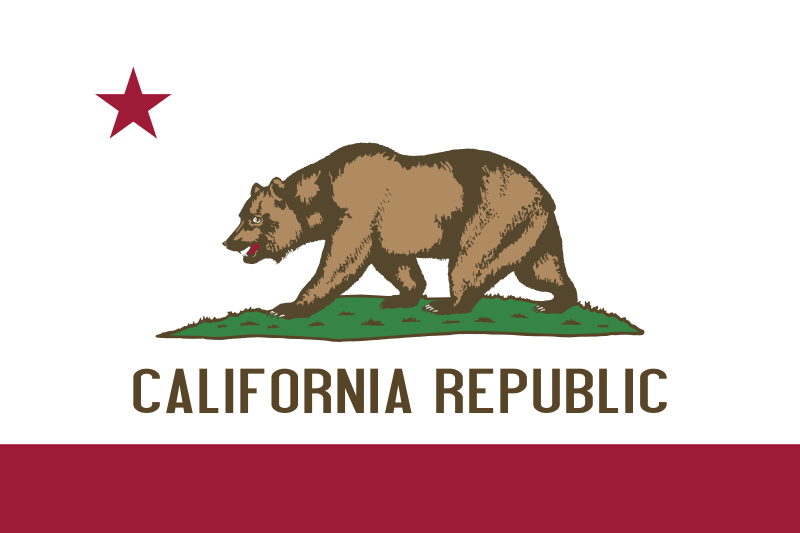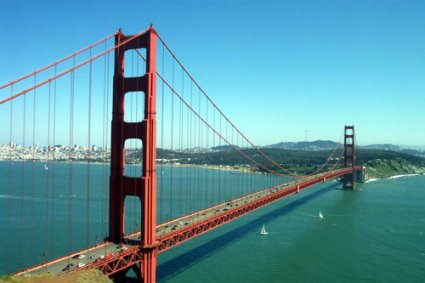US State of California
California is a state located on the West Coast of the United States. It is the most populous U.S. state, home to 1 out of 8 Americans (38 million people), and is the third largest state by area (after Alaska and Texas). California is bordered by Oregon to the north, Nevada to the east, Arizona to the southeast, and the Mexican State of Baja California to the south. It is home to the nation's second and fifth most populous census statistical areas (Greater Los Angeles area and San Francisco Bay Area, respectively), and eight of the nation's 50 most populated cities (Los Angeles, San Diego, San Jose, San Francisco, Fresno, Sacramento, Long Beach, and Oakland). The capital city is Sacramento.
What is now California was first settled by various Native American tribes before being explored by a number of European expeditions throughout the 16th and 17th centuries. It was then claimed by the Spanish Empire as part of Alta California in the larger territory of New Spain. Alta California became a part of Mexico in 1821 following its successful war for independence, but would later be ceded to the United States in 1848 after the Mexican-American War. The western portion of Alta California was soon organized as the State of California, which was admitted as the 31st state on September 9, 1850. The California Gold Rush starting in 1848 led to dramatic social and demographic change, with large scale immigration from the U.S. and abroad and an accompanying economic boom.
California's diverse geography ranges from the Pacific Coast in the west, to the Sierra Nevada in the east – from the Redwood–Douglas-fir forests of the northwest, to the Mojave Desert areas in the southeast. The center of the state is dominated by the Central Valley, a major agricultural area. California contains both the highest and lowest points in the contiguous United States (Mount Whitney and Death Valley), and has the 3rd longest coastline of all states (after Alaska and Florida). Earthquakes are a common occurrence because of the state's location along the Pacific Ring of Fire: about 37,000 are recorded annually.
At least half of the fresh fruit produced in the United States are now cultivated in California, and the state also leads in the production of vegetables. Other important contributors to its economy include aerospace, education, manufacturing, and high-tech industry. If it were a country, it would be the 9th largest economy in the world and the 34th most populous.
California's climate varies from Mediterranean to subarctic. Much of the state has a Mediterranean climate, with cool, rainy winters and dry summers. The cool California Current offshore often creates summer fog near the coast. Farther inland, one encounters colder winters and hotter summers.
Northern parts of the state average higher annual rainfall than the south. California's mountain ranges influence the climate as well: some of the rainiest parts of the state are west-facing mountain slopes. Northwestern California has a temperate climate, and the Central Valley has a Mediterranean climate but with greater temperature extremes than the coast. The high mountains, including the Sierra Nevada, have an alpine climate with snow in winter and mild to moderate heat in summer.
The east side of California's mountains produce a rain shadow, creating expansive deserts. The higher elevation deserts of eastern California see hot summers and cold winters, while the low deserts east of the southern California mountains experience hot summers and nearly frostless mild winters. Death Valley, a desert with large expanses below sea level, is considered the hottest location in North America; the highest temperature in the Western Hemisphere, 134 °F (57 °C), was recorded there on July 10, 1913. The lowest temperature in California was −45 °F (−43 °C) in 1937 in Boca.
From Wikipedia, the free encyclopedia
Also see our Study in California page



School system in California
Also see our Study in California page
Public secondary education consists of high schools that teach elective courses in trades, languages, and liberal arts with tracks for gifted, college-bound and industrial arts students. California's public educational system is supported by a unique constitutional amendment that requires a minimum annual funding level for grades K-12 and community colleges that grows with the economy and student enrollment figures.[161]
California had over 6.2 million school students in the 2005–06 school year. Funding and staffing levels in California schools lag behind other states. In expenditure per pupil, California ranked 29th (of the 50 states and the District of Columbia) in 2005–06. In teaching staff expenditure per pupil, California ranked 49th of 51. In overall teacher-pupil ratio, California was also 49th, with 21 students per teacher. Only Arizona and Utah were lower.
California's public postsecondary education offers a unique three tiered system:
The research university system in the state is the University of California (UC), a public university system. As of fall 2011, the University of California had a combined student body of 234,464 students. There are ten general UC campuses, and a number of specialized campuses in the UC system. The system was intended to accept the top 10% of California high school students, but under severe budget restrictions, this has since been diminishing. The UC system was originally given direct authority in awarding Ph.Ds, but this has since changed several years ago, California's Master Plan for Higher Education granting the CSU to award several Doctoral degrees.
The California State University (CSU) system has almost 430,000 students, making it the largest university system in the United States. CSU was intended to accept the top one-third of high school students, but under severe budget woes and record amount of applications, this has since changed. The CSU originally began as an educational system primarily intended for undergraduate education, but has since changed under California's Master Plan for Higher Education. The CSU has been granted the authority to award an ample amount of Doctoral degrees today. The California Community Colleges System provides lower division coursework as well as basic skills and workforce training. It is the largest network of higher education in the US, composed of 112 colleges serving a student population of over 2.6 million.
California is also home to such notable private universities as Stanford University, the University of Southern California, the California Institute of Technology, and the Claremont Colleges. California has hundreds of other private colleges and universities, including many religious and special-purpose institutions.
From Wikipedia, the free encyclopedia












